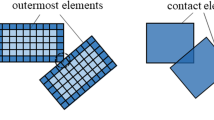Abstract
We propose two methods to improve the arrangement of oriented particles for position-based dynamics simulation. The first method, within object particle arrangement, segments a target mesh and places a single ellipsoidal particle in each segment. Because the number of oriented particles for simulation is smaller than the number used in a conventional arrangement method which randomly places spherical particles on the target mesh’s surface, we can calculate simulation results more quickly. The second method, on surface particle arrangement, which arranges ellipsoidal particles on the surface of the target mesh, behaves similarly to the conventional method. However, we improve the conventional method by optimizing the position and radiuses of the particles to solve the problem of the protrusion of particles from the mesh surface, which produces inaccurate collision handling results. Based on the results of various experiments, we show that simulations using the oriented particle structures constructed by the proposed methods are more efficient and accurate than those conducted using the conventional method. In addition, we compare the soft body simulation characteristics that appear based on the two proposed methods.















Similar content being viewed by others
References
Attene, M., Falcidieno, B., Spagnuolo, M.: Hierarchical mesh segmentation based on fitting primitives. Vis. Comput. 22(3), 181–193 (2006)
Bender, J., Müller, M., Otaduy, M.A., Teschner, M.: Position-based methods for the simulation of solid objects in computer graphics. In: EUROGRAPHICS 2013 State of the Art Reports (2013)
Bischoff, S., Kobbelt, L.: Ellipsoid decomposition of 3d-models. In: 1st international symposium on 3D Data Processing Visualization and Transmission, 2002. Proceedings, pp. 480–488. IEEE (2002)
Cohen-Steiner, D., Alliez, P., Desbrun, M.: Variational shape approximation. ACM Trans. Gr. (TOG) 23, 905–914 (2004)
Katz, S., Leifman, G., Tal, A.: Mesh segmentation using feature point and core extraction. Vis. Comput. 21(8–10), 649–658 (2005)
Lu, L., Choi, Y.K., Wang, W., Kim, M.S.: Variational 3d shape segmentation for bounding volume computation. In: Computer Graphics Forum, vol. 26, pp. 329–338. Wiley Online Library (2007)
Macklin, M., Müller, M., Chentanez, N.: Xpbd: Position-based simulation of compliant constrained dynamics. In: Proceedings of the 9th International Conference on Motion in Games, MIG ’16, pp. 49–54. ACM, New York (2016). doi:10.1145/2994258.2994272
Müller, M., Chentanez, N.: Adding Physics to Animated Characters with Oriented Particles. In: J. Bender, K. Erleben, E. Galin (eds.) Workshop in Virtual Reality Interactions and Physical Simulation ”VRIPHYS” (2011). The Eurographics Association (2011). doi:10.2312/PE/vriphys/vriphys11/083-091
Müller, M., Chentanez, N.: Solid simulation with oriented particles. ACM Trans. Gr. (TOG), vol. 30, p. 92 (2011)
Müller, M., Chentanez, N., Macklin, M.: Simulating visual geometry. In: Proceedings of the 9th International Conference on Motion in Games, MIG ’16, pp. 31–38. ACM, New York (2016). doi:10.1145/2994258.2994260
Müller, M., Heidelberger, B., Hennix, M., Ratcliff, J.: Position based dynamics. J. Vis. Commun. Image Represent. 18(2), 109–118 (2007)
Müller, M., Heidelberger, B., Teschner, M., Gross, M.: Meshless deformations based on shape matching. ACM Trans. Gr. (TOG) 24, 471–478 (2005)
Shapira, L., Shamir, A., Cohen-Or, D.: Consistent mesh partitioning and skeletonisation using the shape diameter function. Vis. Comput. 24(4), 249–259 (2008)
Shlens, J.: A tutorial on principal component analysis. In: Systems Neurobiology Laboratory, Salk Institute for Biological Studies (2005)
Simari, P.D., Singh, K.: Extraction and remeshing of ellipsoidal representations from mesh data. In: Proceedings of Graphics Interface 2005, pp. 161–168. Canadian Human-Computer Communications Society (2005)
Svanberg, K.: A class of globally convergent optimization methods based on conservative convex separable approximations. SIAM J. Optim. 12(2), 555–573 (2002)
Wang, R., Zhou, K., Snyder, J., Liu, X., Bao, H., Peng, Q., Guo, B.: Variational sphere set approximation for solid objects. Vis. Comput. 22(9–11), 612–621 (2006)
Yaz, I.O., Loriot, S.: Triangulated surface mesh segmentation. In: CGAL User and Reference Manual, 4.8.1 edn. CGAL Editorial Board (2016). http://doc.cgal.org/4.8.1/Manual/packages.html#PkgSurfaceSegmentationSummary
Zabih, R., Kolmogorov, V.: Spatially coherent clustering using graph cuts. In: Computer Vision and Pattern Recognition, 2004. CVPR 2004., vol. 2, pp. 437–444. IEEE (2004)
Author information
Authors and Affiliations
Corresponding author
Electronic supplementary material
Below is the link to the electronic supplementary material.
Supplementary material 1 (avi 20599 KB)
Rights and permissions
About this article
Cite this article
Oh, Y.J., Shin, Y. & Lee, IK. Efficient oriented particle arrangements for position-based dynamics simulation. Vis Comput 34, 507–516 (2018). https://doi.org/10.1007/s00371-017-1356-y
Published:
Issue Date:
DOI: https://doi.org/10.1007/s00371-017-1356-y




